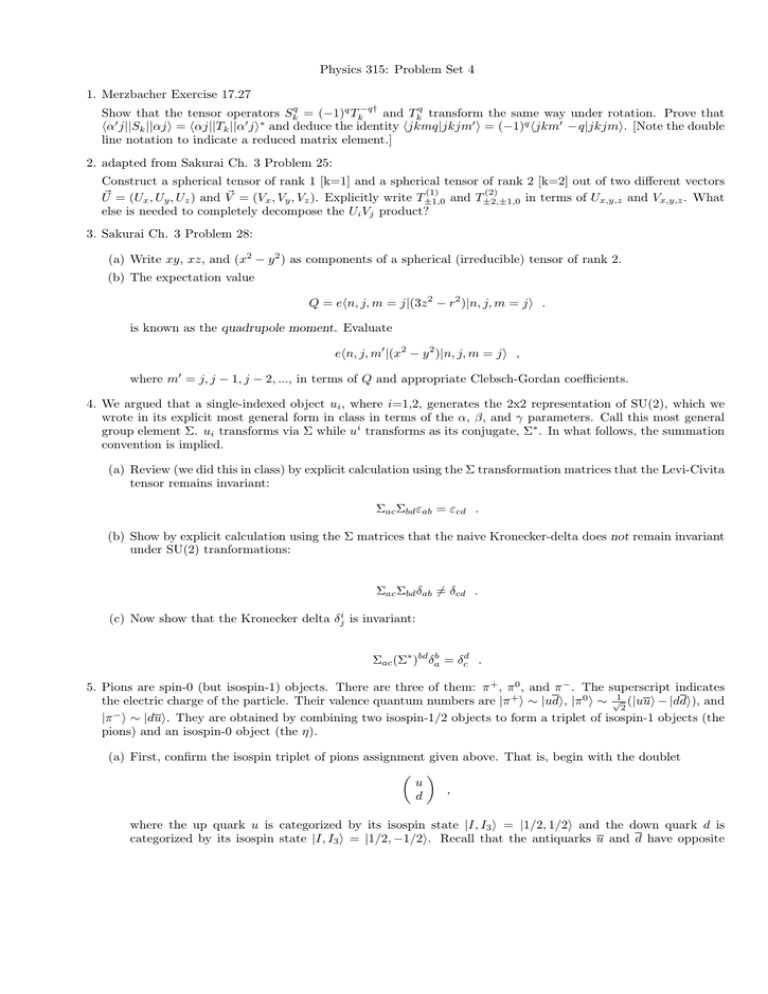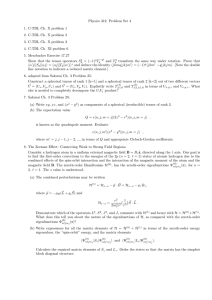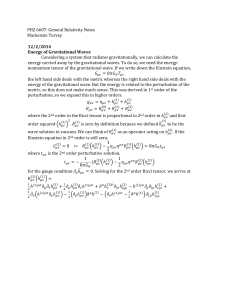Physics 315: Problem Set 4 1. Merzbacher Exercise 17.27 = (−1)
advertisement

Physics 315: Problem Set 4 1. Merzbacher Exercise 17.27 Show that the tensor operators Skq = (−1)q Tk−q† and Tkq transform the same way under rotation. Prove that hα0 j||Sk ||αji = hαj||Tk ||α0 ji∗ and deduce the identity hjkmq|jkjm0 i = (−1)q hjkm0 −q|jkjmi. [Note the double line notation to indicate a reduced matrix element.] 2. adapted from Sakurai Ch. 3 Problem 25: Construct a spherical tensor of rank 1 [k=1] and a spherical tensor of rank 2 [k=2] out of two different vectors ~ = (Ux , Uy , Uz ) and V ~ = (Vx , Vy , Vz ). Explicitly write T (1) and T (2) U ±1,0 ±2,±1,0 in terms of Ux,y,z and Vx,y,z . What else is needed to completely decompose the Ui Vj product? 3. Sakurai Ch. 3 Problem 28: (a) Write xy, xz, and (x2 − y 2 ) as components of a spherical (irreducible) tensor of rank 2. (b) The expectation value Q = ehn, j, m = j|(3z 2 − r2 )|n, j, m = ji . is known as the quadrupole moment. Evaluate ehn, j, m0 |(x2 − y 2 )|n, j, m = ji , where m0 = j, j − 1, j − 2, ..., in terms of Q and appropriate Clebsch-Gordan coefficients. 4. We argued that a single-indexed object ui , where i=1,2, generates the 2x2 representation of SU(2), which we wrote in its explicit most general form in class in terms of the α, β, and γ parameters. Call this most general group element Σ. ui transforms via Σ while ui transforms as its conjugate, Σ∗ . In what follows, the summation convention is implied. (a) Review (we did this in class) by explicit calculation using the Σ transformation matrices that the Levi-Civita tensor remains invariant: Σac Σbd εab = εcd . (b) Show by explicit calculation using the Σ matrices that the naive Kronecker-delta does not remain invariant under SU(2) tranformations: Σac Σbd δab 6= δcd . (c) Now show that the Kronecker delta δji is invariant: Σac (Σ∗ )bd δab = δcd . 5. Pions are spin-0 (but isospin-1) objects. There are three of them: π + , π 0 , and π − . The superscript indicates the electric charge of the particle. Their valence quantum numbers are |π + i ∼ |udi, |π 0 i ∼ √12 (|uui − |ddi), and |π − i ∼ |dui. They are obtained by combining two isospin-1/2 objects to form a triplet of isospin-1 objects (the pions) and an isospin-0 object (the η). (a) First, confirm the isospin triplet of pions assignment given above. That is, begin with the doublet u , d where the up quark u is categorized by its isospin state |I, I3 i = |1/2, 1/2i and the down quark d is categorized by its isospin state |I, I3 i = |1/2, −1/2i. Recall that the antiquarks u and d have opposite electric charge and opposite I3 quantum number from their quark counterparts. Therefore, u has the isospin quantum numbers |I, I3 i = |1/2, −1/2i and d has the isospin quantum numbers |I, I3 i = |1/2, 1/2i. u The doublet transforms as a 2 under SU(2) (multiplicity=2 · (I = 1/2) + 1). u d on the other d hand, transforms like a 2 under SU(2). However, you just showed that the Levi-Civita tensor is invariant under an SU(2) rotation, so it can be used to change the 2 objects to 2 objects: If ai (i = 1, 2) indicates the components of u d , find bj = jk ak , summation implied. So you have just found how to express the antiquarks as a 2. (The epsilon tensor behaves as a raising or lowering operator in SU(2) the way the metric tensor gµν is used to raise or lower Lorentz indices.) You know how to combine 2 ⊗ 2 from your spin work, so do that in order to write the triplet of pions, |I, I3 i = |1, 1i, |1, 0i, and |1, −1i in terms of the quark basis. How do the expressions compare to the triplet you obtain by combining two (regular) spin-1/2 objects? (b) Show that all possible electrically neutral two-pion final states have total isospin I = 0 or 2 and I3 = 0. Express these states in terms of the single pion basis.






